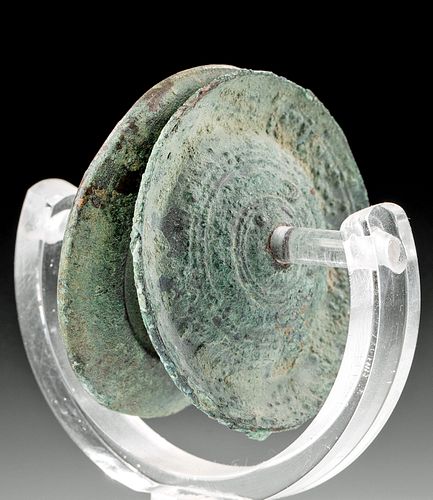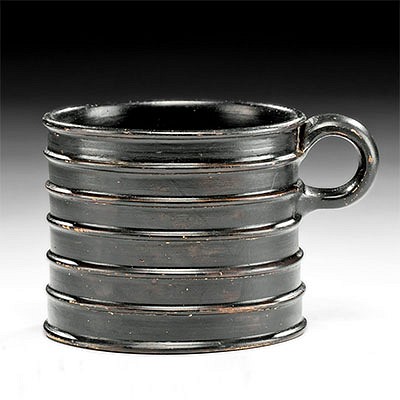Lot of 2 Greek Hellenistic Bronze Krotala / Cymbals
Lot 39
About Seller
Artemis Gallery
686 S Taylor Ave, Ste 106
Louisville, CO 80027
United States
Selling antiquities, ancient and ethnographic art online since 1993, Artemis Gallery specializes in Classical Antiquities (Egyptian, Greek, Roman, Near Eastern), Asian, Pre-Columbian, African / Tribal / Oceanographic art. Our extensive inventory includes pottery, stone, metal, wood, glass and textil...Read more
Categories
Estimate:
$1,000 - $1,500
Absentee vs Live bid
Two ways to bid:
- Leave a max absentee bid and the platform will bid on your behalf up to your maximum bid during the live auction.
- Bid live during the auction and your bids will be submitted real-time to the auctioneer.
Bid Increments
| Price | Bid Increment |
|---|---|
| $0 | $25 |
| $300 | $50 |
| $1,000 | $100 |
| $2,000 | $250 |
| $5,000 | $500 |
| $10,000 | $1,000 |
| $20,000 | $2,500 |
| $50,000 | $5,000 |
| $100,000 | $10,000 |
| $200,000 | $20,000 |
About Auction
By Artemis Gallery
Mar 12, 2020
Set Reminder
2020-03-12 10:00:00
2020-03-12 10:00:00
America/New_York
Bidsquare
Bidsquare : Ancient / Ethnographic Around The World
https://www.bidsquare.com/auctions/artemis-gallery/ancient-ethnographic-around-the-world-4957
Ancient art from Egypt, Greece, Italy and the Near East, as well as Asian, Fossils, Pre-Columbian, Native American, African / Tribal / Oceanic, Spanish Colonial, Russian Icons, Fine art, much more! Artemis Gallery info@artemisgallery.com
Ancient art from Egypt, Greece, Italy and the Near East, as well as Asian, Fossils, Pre-Columbian, Native American, African / Tribal / Oceanic, Spanish Colonial, Russian Icons, Fine art, much more! Artemis Gallery info@artemisgallery.com
- Lot Description
Greece, Hellenistic Period, ca. 3rd to 1st century BCE. A fine and rare pair of bronze finger cymbals called krotala (singular krotalon) used by female or dwarf dancers and performers (called krotalistriae). Each krotalon is constructed from a flat sheet of bronze that is mold-cast with a concave body, an upturned rim, and protruding central kick with a petite perforation. The tops of the cymbals are adorned with a series of raised concentric rings that form a minimalist bullseye motif. Krotala like these would have been suspended to the dancer's forefinger and thumb via twisted strands and struck rhythmically to create a bright ringing sound; the concave body and flared rim enabled the elongated reverberation of the sound created. Fine patina has enveloped both instruments. Similar to the modern Spanish castanet, krotala were often played ceremonially during certain events. Size of each (both are relatively similar): 2.1" Diameter (5.3 cm); 4.75" H (12.1 cm) on included custom stand.
Provenance: private Orange County, California, USA collection, acquired prior to 2000; ex-The Archaeological Center, Jaffa, Israel; ex-Robert Deutsch collection
All items legal to buy/sell under U.S. Statute covering cultural patrimony Code 2600, CHAPTER 14, and are guaranteed to be as described or your money back.
A Certificate of Authenticity will accompany all winning bids.
We ship worldwide and handle all shipping in-house for your convenience.
#153679Both items have very slight bending to overall forms, light encrustations, and softening to some concentric rings on topside, otherwise intact and very good. Light earthen deposits and wonderful patina throughout.Condition
- Shipping Info
-
All shipping is handled in-house for your convenience. Your invoice from Artemis Gallery will include shipping calculation instructions. If in doubt, please inquire BEFORE bidding for estimated shipping costs for individual items.
-
- Buyer's Premium



 EUR
EUR CAD
CAD AUD
AUD GBP
GBP MXN
MXN HKD
HKD CNY
CNY MYR
MYR SEK
SEK SGD
SGD CHF
CHF THB
THB















